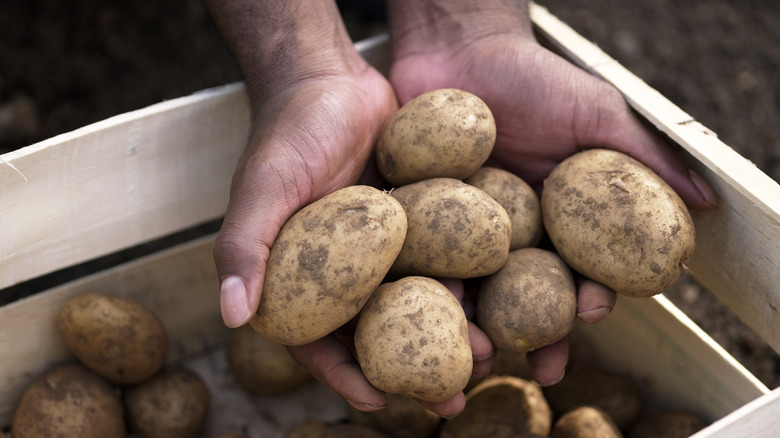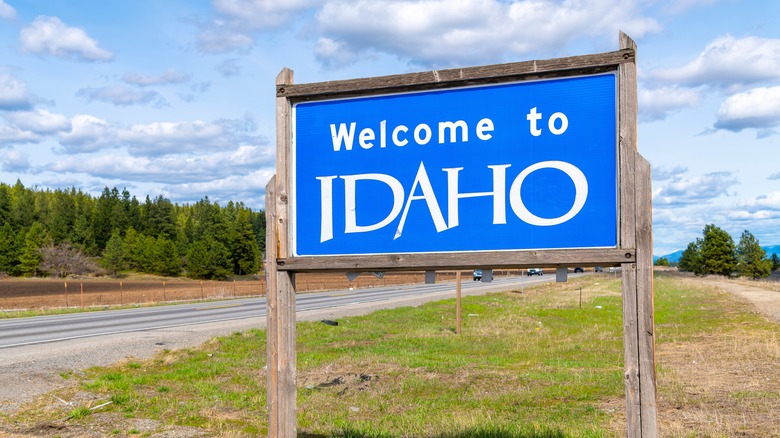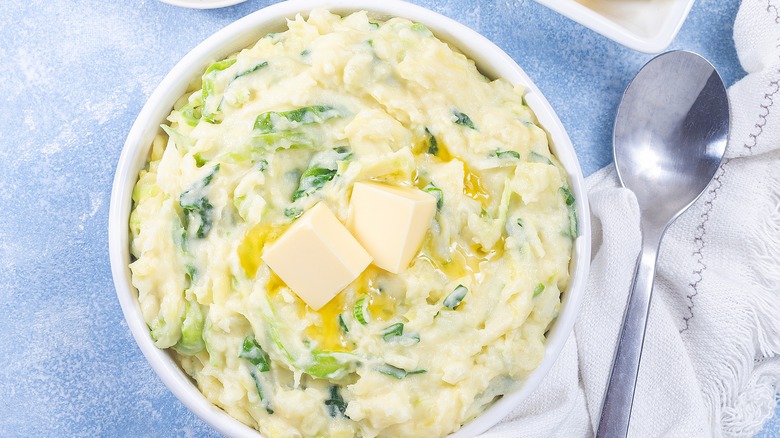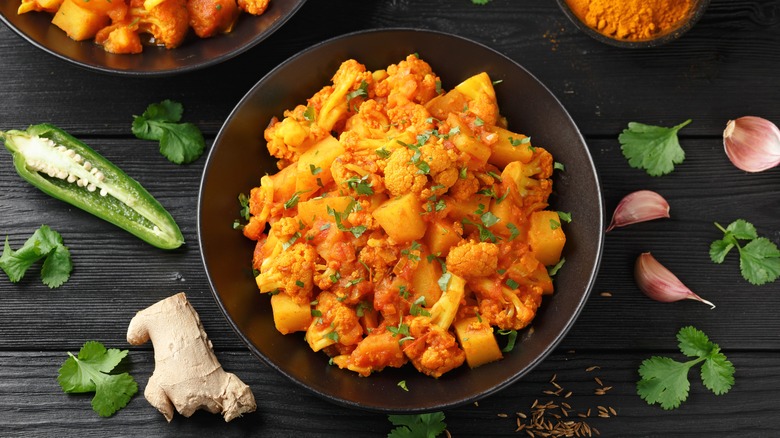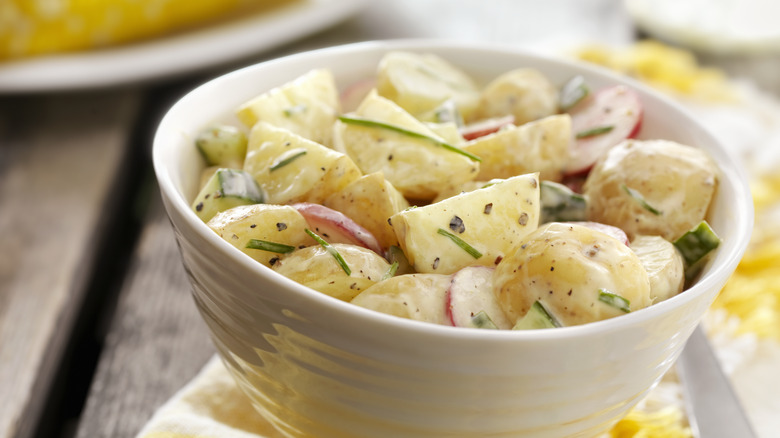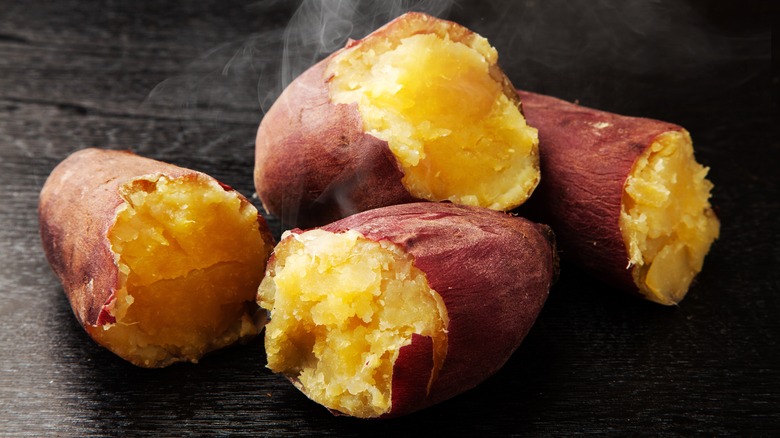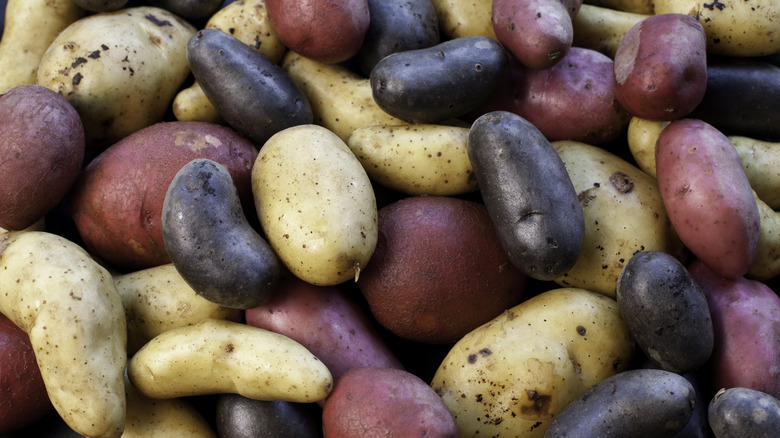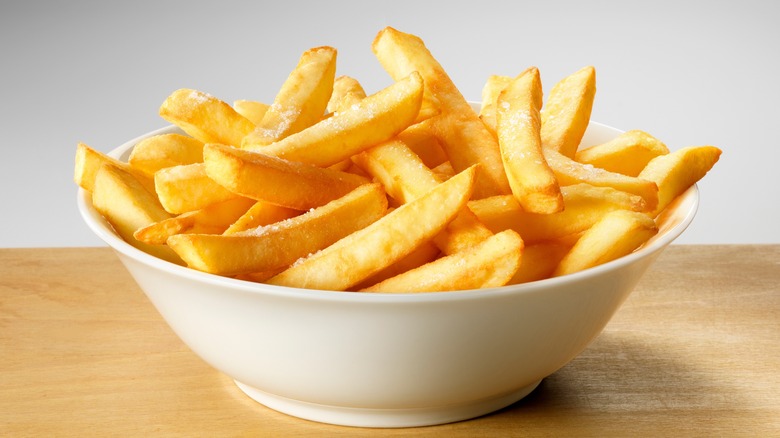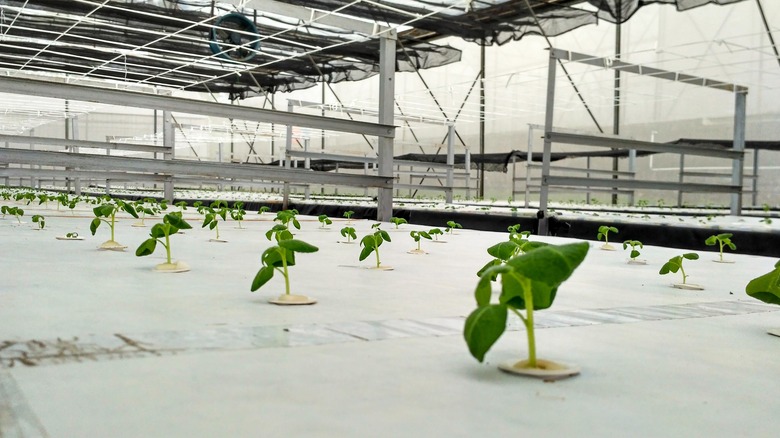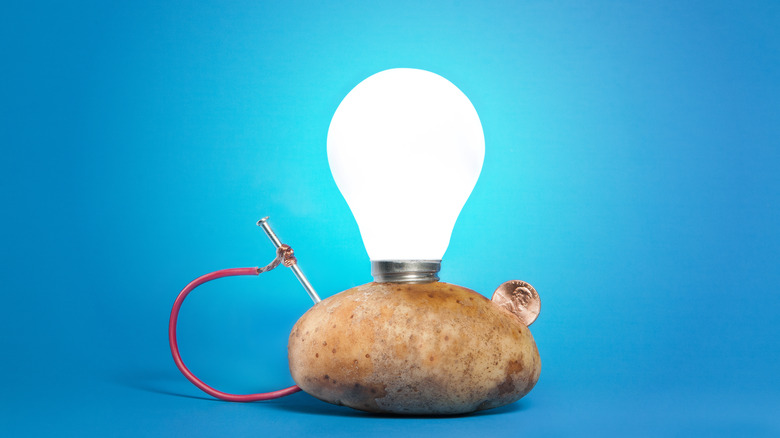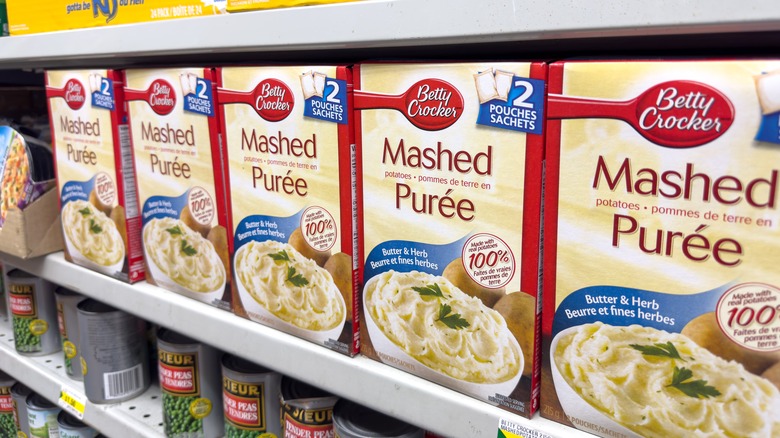False Facts About Potatoes You Thought Were True
When was the last time you really considered the humble potato? Potatoes may often get a guest-starring role at dinner, popping up in sides like mashed potatoes or French fries far more often than they take a main character role, but they shouldn't be overlooked. Potatoes are America's favorite vegetable, with the average American consuming 120 pounds every year. And for a food we love so much, it may come as a surprise how little we know about it.
While well-known to the Americas, potatoes only arrived in Europe in the 18th century, and at first, they were regarded with some skepticism. A member of the nightshade family, potatoes were often believed to be poisonous. It took converts like French agronomist Antoine-Augustin Parmentier to convince people to give them a try, which he did with a particularly successful marketing coup: persuading the king and queen of France to wear potato blossoms. (It probably didn't hurt that bread prices had recently skyrocketed, leading the poor to seek out alternate means of nourishment.)
This wild story is true; by contrast, however, many things you might think you knew about potatoes are pure myth. Here are some of the false facts about potatoes it's high time you stopped believing.
False: American potatoes all come from Idaho
Idaho seems synonymous with potatoes, and for good reason: Idaho produces about a third of the potatoes in the U.S. But of course, not all potatoes in America grow in Idaho; in fact, despite being a relatively new player in the potato-growing field, Washington takes second place as a spud supplier. Together, the two states produce more than half of the annual potato supply nationwide. And what's more, even Idaho hasn't actually been growing potatoes for all that long, all things considered: Potatoes' first American port of call was New Hampshire in 1719. It would take more than a century for the crop to reach Idaho in 1836.
That said, Idaho is indeed known for excellent-quality, inexpensive potatoes, of which a majority are of the russet variety. In fact, Idaho is so synonymous with potatoes, specifically russets, that many Americans use the terms Idaho potato and russet potato interchangeably.
False: Potatoes come from Ireland
The Irish may be masters of the potato, with a number of different recipes, from colcannon, which sees them mashed with greens and butter, to golden fried potato cakes. They even tell fortunes in plates of mash! But potatoes don't come from Ireland, at least not originally. Rather, they hail from Peru, where they were cultivated by the Incas as early as 200 BC; nearly 4,000 varieties of potato can be found in the Andes alone.
Potatoes arrived in Ireland thanks to the Spanish, who brought potatoes to Europe in the 16th century. They likely arrived in Ireland by the turn of the century, though exactly when and how they made their appearance is some matter of debate. What we do know is that they were quickly embraced by the locals as an easy-to-grow, inexpensive, nutritious dietary staple — so much so that when, in 1845, a blight took out the local potato crop, a third of the Irish population faced sudden food scarcity due to their reliance on the humble tuber.
False: Potatoes are bad for you
Potatoes hardly have a rep as a health food, and that's no surprise: Whether mashed with butter, deep-fried in oil, or scalloped with cheese and cream, potatoes are often transformed into rich, comfort food dishes that pack the calories. But in and of themselves, potatoes are actually pretty good for you. Rich in vitamin C, potatoes have long been essential for warding off scurvy in areas like Ireland, and their absence during the Great Famine led to a major resurgence of this disease among the poor.
In addition to vitamin C, potatoes are also rich in potassium, an electrolyte essential for heart, muscle, and nervous system function, as well as certain B vitamins like niacin, thiamin, and B6.
While potatoes certainly don't lose these health benefits when prepared in rich, creamy recipes, you can reap these benefits with a lower caloric load by preparing potatoes in slightly less decadent but equally delicious ways. Consider pairing them with fiber-rich cauliflower and a host of warming, anti-inflammatory spices to make an Indian aloo gobi as fragrant and flavorful as it is nutritious.
False: Potatoes are best eaten hot
The vast majority of the most beloved potato dishes are enjoyed hot, from mash to baked, gratin to shepherd's pie. But there's an argument to be made for cold potato preparations — at least from a nutritional standpoint.
Research has shown that potatoes that are cooked and then cooled develop resistant starch, which is more difficult to digest. While this might sound like a problem, it's actually an advantage: Resistant starch is a prebiotic that not only helps you stay fuller longer but, seeing as it arrives intact in the colon, can help feed good gut bacteria. Keeping these little microbes happy can contribute to better mood and better awareness of satiety, not to mention lowered inflammation and improved insulin sensitivity. (All the more reason to dish up the potato salad.)
But you don't actually have to eat your potatoes cold to reap these benefits. Research has shown that potatoes retain this added benefit when cooked, cooled, and reheated, with red and yellow potatoes retaining even more of the nutritious benefits than reheated russets.
False: Potatoes and sweet potatoes are members of the same family
Despite boasting similar names, sweet potatoes and potatoes aren't the same thing. In fact, they aren't even related. While both sweet potatoes and potatoes are indeed root vegetables, meaning they grow under the ground, the similarities stop there. Sweet potatoes are members of the Convolvulaceae family, the same genus from whence the morning glory hails. Potatoes, meanwhile, are Solanaceae or nightshades like eggplant, tomatoes, and belladonna.
Sweet potatoes and potatoes also boast fairly different nutritional profiles. While both contain approximately the same amount of calories, protein, fat, and carbs, sweet potatoes are way higher in vitamin A (we're talking 107% of your daily recommended intake, as compared to a paltry 0.1% for regular potatoes). Sweet potatoes are also a bit richer in fiber, vitamin B6, vitamin C, and calcium. Potatoes win out in just one category: a slightly higher potassium content.
False: It doesn't matter which potato variety you use
Within the greater family of potatoes, you'll find loads of different varieties, from tiny new potatoes to purple Vitelottes. And each potato has its own strengths.
Most potatoes fall into one of two categories: waxy or floury. Yukon Golds are the most famous of the former category, boasting a dense flesh that holds together well when cooked, making them perfect for potato salads and stews where you want potatoes to hold their shape. Floury potatoes, like russets, tend to fall apart when boiled, but they bake up fluffy and light with a crispy skin. These are perfect for fluffy mashed potatoes or roasties.
On the smaller side of things, fingerling and new potatoes are both perfect for cooking whole in their skins. Fingerlings are long and slender, while new potatoes tend to be round and are, as their name suggests, simply immature specimens of classic potatoes.
False: Thomas Jefferson invented French fries
Thomas Jefferson gets the credit for a whole lot of things he didn't invent, including mac and cheese and dumbwaiters. And while the former president also didn't invent French fries, he may well have popularized them Stateside.
Like many of Jefferson's purported "inventions," fried potatoes were a discovery he made while serving as a diplomat in France. Once he returned to his Monticello, he continued to enjoy them, ostensibly having them served at a dinner party he held in 1802. However, there's no evidence that they appeared on the table — or indeed that Jefferson's iteration of fried potatoes resembled the fries of today. After all, they are referenced in the recipe files of James Hemings, the enslaved cook Jefferson brought with him to France, as "pommes de terre frites à cru, en petites tranches," which translates from French as "potatoes fried from raw, in little slices." Could they be fries? Sure. But they could also be home fries.
Regardless of Jefferson's involvement, French fries have since become wildly popular in the U.S., with about a third of American-grown potatoes being transformed into frozen fries.
False: Potatoes can only grow on Earth
We have not yet found evidence of Martian spuds, but potatoes have indeed been grown in outer space. In 1995, NASA and the University of Wisconsin collaborated on an experiment to grow potatoes on the Columbia space shuttle.
This wasn't just a question of seeing if it was possible. Rather, the experiment sought to understand how zero-gravity and microgravity conditions impacted the growth of the plants. If successful, the researchers hoped the experiment would help them develop feasible ways of guaranteeing food for astronauts on longer missions. Seeing as potatoes are fairly hardy and nutritious, they seemed like the perfect contender! The resulting potatoes developed exactly the same as their earthly counterparts.
But in spite of the success of the experiment, potatoes aren't likely to form the backbone of space mission menus any time soon. Since cooking is complicated on board a space station, salad greens have become a more viable option, and while the potato was indeed the first veggie grown in space, in 2015, red romaine lettuce became the first plant to be both grown and consumed, not on earth.
False: Potatoes are unique in their ability to be transformed into a battery
If you were a nerdy kid, you probably tried your hand at making a potato clock or a potato battery. This at-home experiment is pretty simple to replicate, requiring just a few wires and two bits of metal to form the positive and negative electrodes. The former is usually made with a source of copper, like a penny; the latter should contain zinc, which you'll find in a galvanized nail. Connect them with the wires running through the potato, and you can power a clock or a lightbulb like magic!
But potatoes are far from the only vegetable with this superpower. It's not the potato itself but rather the acid in the potato that makes the battery run. In theory, then, any fruit or vegetable could be used to conduct the same experiment, from an apple all the way to a zucchini.
False: Instant mashed potatoes are fake potatoes
Shelf-stable, easy to prepare, and totally devoid of lumps, instant mashed potatoes have long been a pantry staple for cooks short on time. But before you go assuming that just because they come out of a box, they must be fake food, think again: Instant mashed potatoes actually begin with the real thing.
Instant mashed potatoes are made by dehydrating actual potatoes and transforming them into granules or, more often, flakes. First created in 1953 in Philadelphia, instant mashed potatoes have since become popular all over the world. (Some experts even prefer them to fresh.) Instant mashed potatoes don't just cook up into a quick, smooth purée in mere minutes. They also can be used to create a crust for crispy, air-fried veggies. Jacques Pepin even uses them as a thickening agent. All the more reason to make sure you've always got some in the pantry.
